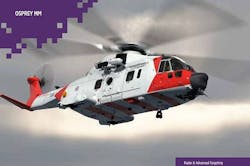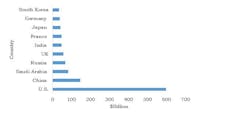AESA systems, security concerns boost demand for airborne fire control radar
By Chetan More, Allied Market Research (https://www.alliedmarketresearch.com)
The emergence of active electronically scanned array (AESA) radar systems, coupled with the rising security concerns in world nations, has led to growth in the airborne fire control radar market.
The global environment witnesses dramatic socio-economic and political changes between countries and international bodies. In this scenario, the issue of national security and sustenance of military technologies takes paramount importance for reigning governments. The rise in research and development activities on warfare techniques has augmented the airborne fire control radar market.
There is greater implementation of fire control radars in military aircraft due to growing security concerns with respect to territorial conflicts between nations. Each country is actively investing mammoth sums of money in creating a larger and distinguished defense base. The increasing focus of militaries in employing surveillance radar technology with greater accuracy in target location has ensured that there is greater need for weapon control radars. Along with the transition towards AESA (active electronically scanned array) systems, the world airborne fire control radar market is expected to grow exponentially.
Evolving state-of-the-art airborne infrastructure for security and commercial purposes has become the prime focus of developed and developing countries. The airborne fire control market has been extensively studied in detail by researchers at Allied Market Research, who estimated the total value of the industry at $2,643 million ($2.6 billion) in 2015. As it is a niche industry with limited players in the market, it is expected to grow at a compound annual growth rate (CAGR) of 3.9 percent until the year 2022.
Increased military expenditure propels radar sales
The airborne fire control radar market has an established consumer base in developed nations. Countries such as the U.S., Russia, and the U.K. have sufficient resources to invest in defense equipment and machinery.
The industry is also facing a surge in its consumption, especially in developing economies of Asia-Pacific and LAMEA (Brazil, Argentina, Nigeria, South Africa, Iraq, Iran, Algeria, Saudi Arabia, and Egypt), which spend a large portion of their gross domestic product (GDP) on defense. These regions face the issue of territorial conflicts triggered due to clash of political and economic interests. To secure their borders and ensure no stealth technologies by alien countries enter their territory, their need for fire control radar systems in air force systems is increasing.
FIG. 1: TOP COUNTRIES BY MILITARY EXPENDITURE (2015)
Improving combat techniques
Aircraft earlier has mechanical scanning systems in place for skimming across air terrains to estimate the coordinates of a target and enable efficient military communication. These systems were prone to failure that resulted in the entire aircraft being grounded, and the entire radar system disabled. However, with the emergence of technology, the airborne fire control radars are increasingly being adopted with AESA systems to deal with the problem of aircraft failure. By evaluating the position of target, it aids in informing the fire control system installed on the missiles through a high-pulse repetitive frequency and narrow beam width.
AESA systems use solid-state technology and electronic scanning and allow longer standoff range. This enables better detection range and first shoot/kill by missiles beyond visual range mode. Longer standoff time permits more time for tactical analysis, information sharing and persistent target observation coupled with critical commander assessment of decisions. The key industry players engaged in the fire control radar market are coming up with better radar systems for enhanced performance. The focus is on product diversification and uniqueness, which will attract revenues from different countries’ economies.
One such company that aims to expand its product portfolio is Leonardo Airborne & Space Systems, which has announced a new, lightweight AESA radar named Osprey that draws on air-to-air and air-to-ground surveillance sensors. The new configuration uses three arrays — in the nose of the aircraft and in each of its main landing gears. It has eliminated the need to install the radar beneath the belly of the aircraft, where it could be susceptible to damage, while landing in snow. The entire system is the first of its type to offer full spherical 360-degree coverage with no moving parts.
Similar technological progressions by other companies have contributed to a dynamic market, with many rivals trying to vie for attention of consumer nations.
The world airborne fire control radar market is a dynamic one with major names such as Thales Group, Raytheon Company, Airbus Group, and Lockheed Martin Corporation involved in it. With supreme concentration on national security and blocking of territorial threat, the demand for airborne fire control radars in military aircraft is rising. Developing nations are also recognizing the need to secure their territories and are initiating military spending on defense equipment. Although a niche industry, the consumption of surveillance and weapon control technology has pushed the market well on its way to being an established one.
Search the Aerospace & Defense Buyer's Guide
You might also like:
Subscribe today to receive all the latest aerospace technology and engineering news, delivered directly to your e-mail inbox twice a week (Tuesdays and Thursdays). Sign upfor your free subscription to the Intelligent Inbox e-newsletter at http://www.intelligent-aerospace.com/subscribe.html.
Connect with Intelligent Aerospace on social media: Twitter (@IntelligentAero), LinkedIn,Google+, and Instagram.
Intelligent Aerospace
Global Aerospace Technology NetworkIntelligent Aerospace, the global aerospace technology network, reports on the latest tools, technologies, and trends of vital importance to aerospace professionals involved in air traffic control, airport operations, satellites and space, and commercial and military avionics on fixed-wing, rotor-wing, and unmanned aircraft throughout the world.



